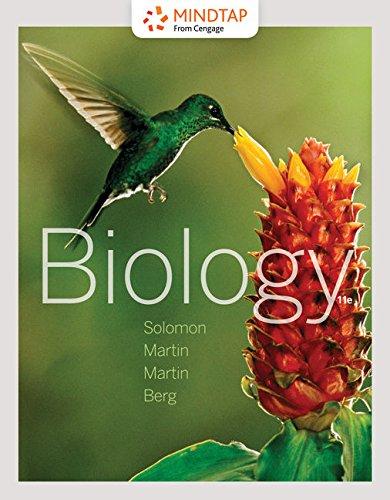
Concept explainers
A nucleosome consists of (a) DNA and scaffolding proteins (b) scaffolding proteins and histones (c) DNA and histones (d) DNA, histones, and scaffolding proteins (e) histones only
Introduction: A chromosome is a thread-like structure made up of DNA. It is tightly packed in the nucleus of a cell. Humans normally have 23 pairs of chromosomes.
Answer to Problem 1TYU
Correct answer: A nucleosome consists of DNA and histones. Hence, the correct answer is option (c).
Explanation of Solution
Reason for the correct answer:
The nucleosome is the basic unit of chromatin structures. The basic unit of each nucleosome contains a bead-like structure that has 146 DNA base pairs wrapped around the disc-shaped core of eight histone molecules. The nucleosomes prevent the DNA from becoming tangled. Histones play an important part in the regulation of gene expression.
Option (c) is given as “DNA and histones”.
The nucleosome consists of DNA and histones.
Hence, the correct answer is option (c).
Reasons for the incorrect answers:
Option (a) is given as “DNA and scaffolding proteins”.
Nucleosomes consist of DNA, but scaffolding proteins are not present in nucleosomes.
Hence, option (a) is incorrect.
Option (b) is given as “scaffolding proteins and histones”.
Scaffolding proteins are modular proteins that play a crucial role in cell-signaling pathways. Scaffolding proteins are not present in nucleosomes. Histones proteins are present in nucleosomes.
Hence, option (b) is incorrect.
Option (d) is given as, “DNA, histones, and scaffolding proteins”.
Nucleosomes consist of DNA and histones, but scaffolding proteins are not present. Hence, option (d) is incorrect.
Option (e) is given as, “histones only”.
Not only histones, but DNA is also present in the nucleosomes.
Hence, option (e) is incorrect.
Hence, options (a), (b), (d), and (e) are incorrect.
The nucleosome is the basic unit of chromatin structures that consist of DNA and histones.
Want to see more full solutions like this?
Chapter 10 Solutions
Mindtap Biology, 1 Term (6 Months) Printed Access Card For Solomon/martin/martin/berg's Biology, 11th
- Noggin mutation: The mouse, one of the phenotypic consequences of Noggin mutationis mispatterning of the spinal cord, in the posterior region of the mouse embryo, suchthat in the hindlimb region the more ventral fates are lost, and the dorsal Pax3 domain isexpanded. (this experiment is not in the lectures).a. Hypothesis for why: What would be your hypothesis for why the ventral fatesare lost and dorsal fates expanded? Include in your answer the words notochord,BMP, SHH and either (or both of) surface ectoderm or lateral plate mesodermarrow_forwardNot part of a graded assignment, from a past midtermarrow_forwardNot part of a graded assignment, from a past midtermarrow_forward
- please helparrow_forwardWhat does the heavy dark line along collecting duct tell us about water reabsorption in this individual at this time? What does the heavy dark line along collecting duct tell us about ADH secretion in this individual at this time?arrow_forwardBiology grade 10 study guidearrow_forward

 Biology (MindTap Course List)BiologyISBN:9781337392938Author:Eldra Solomon, Charles Martin, Diana W. Martin, Linda R. BergPublisher:Cengage Learning
Biology (MindTap Course List)BiologyISBN:9781337392938Author:Eldra Solomon, Charles Martin, Diana W. Martin, Linda R. BergPublisher:Cengage Learning Human Heredity: Principles and Issues (MindTap Co...BiologyISBN:9781305251052Author:Michael CummingsPublisher:Cengage Learning
Human Heredity: Principles and Issues (MindTap Co...BiologyISBN:9781305251052Author:Michael CummingsPublisher:Cengage Learning Anatomy & PhysiologyBiologyISBN:9781938168130Author:Kelly A. Young, James A. Wise, Peter DeSaix, Dean H. Kruse, Brandon Poe, Eddie Johnson, Jody E. Johnson, Oksana Korol, J. Gordon Betts, Mark WomblePublisher:OpenStax College
Anatomy & PhysiologyBiologyISBN:9781938168130Author:Kelly A. Young, James A. Wise, Peter DeSaix, Dean H. Kruse, Brandon Poe, Eddie Johnson, Jody E. Johnson, Oksana Korol, J. Gordon Betts, Mark WomblePublisher:OpenStax College Biology: The Dynamic Science (MindTap Course List)BiologyISBN:9781305389892Author:Peter J. Russell, Paul E. Hertz, Beverly McMillanPublisher:Cengage Learning
Biology: The Dynamic Science (MindTap Course List)BiologyISBN:9781305389892Author:Peter J. Russell, Paul E. Hertz, Beverly McMillanPublisher:Cengage Learning Concepts of BiologyBiologyISBN:9781938168116Author:Samantha Fowler, Rebecca Roush, James WisePublisher:OpenStax College
Concepts of BiologyBiologyISBN:9781938168116Author:Samantha Fowler, Rebecca Roush, James WisePublisher:OpenStax College





